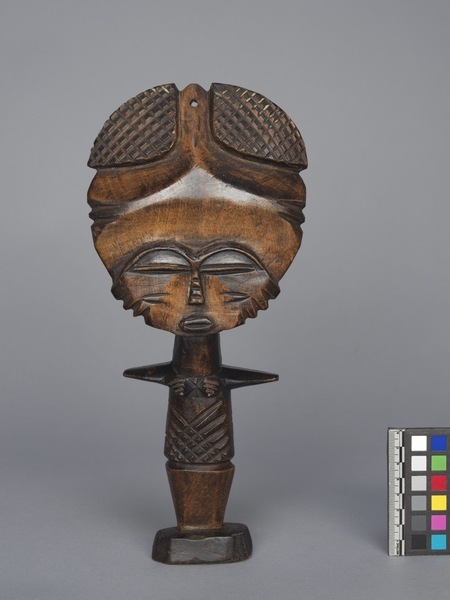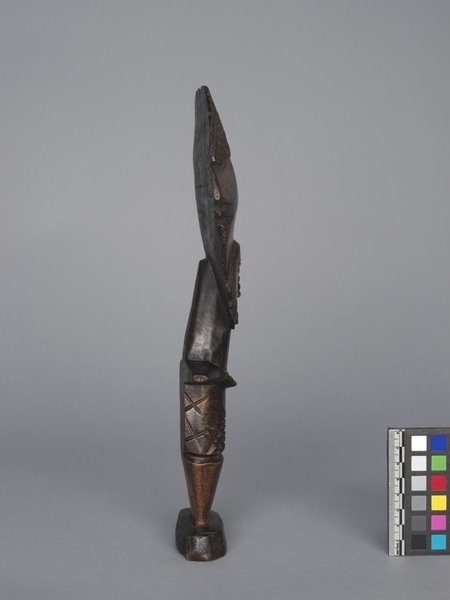Fertility Figure Item Number: 3192/1 from the MOA: University of British Columbia


Description
Fertility figure (akuaba) in female form. Head is large and round, flat in profile, with cross-hatched hair at top, a slightly protruding forehead, and a small face. Eyes are wide, closed, and nose is small and straight. Decorative gouges decorate the cheeks. Below a long thin neck are small breasts emerging from the torso between stubby arms held to the sides. Stomach is covered with cross-hatched grooves. Legs narrow toward bottom, where they meet the small rectangular base. Back of figure is undecorated.
History Of Use
Akuaba fertility figures were carved for young Asante women in order to promote fertility and to ensure the beauty of a child. Women would have them carved by an adwinfo (carver), who were usually recommended to them by a priest. The figures were then carried close to the body, often wrapped in cloth around the waist or back, and treated like a real child. A woman would carry the figure until she became visibly pregnant or until she gave birth. After the birth of the child, Akuaba figures would often be used in shrines or as an offering to the gods. They were also sometimes used as memorials to children and became family heirlooms that were taken care of and passed down through generations. The origins of this practice are from the story of Akua, an Akan woman who was infertile but strongly desired children. She was instructed by a priest to commission a carving of a child which she would carry and treat as if it were real. Despite being ridiculed, Akua followed the instructions and was able to conceive a child. The practice was soon adopted throughout the region. Akuaba are now commonly sold in markets and used for decoration.
Narrative
Given to the donor as a gift in the late 1960s, when she was working, in France, for the French Government (Union Nationale des Maisons Familiales Rurales d'Education et d'Orientation).
Iconographic Meaning
The shape of the Akuaba figure represents the idealized standard of beauty for the Akan. The varying sizes of the different parts of the body are a reflection of an Akan carver’s idea of "proportions of significance". The head in most cases is large and the most dominate feature of the figure as it is considered the seat of wisdom, life, and survival. Akuaba figures would also be decorated with beads to ensure that child would be beautiful and as a way to show wealth, and how well cared for the child would be. All traditional Akuaba figures are female images, primarily because Akua's first child was a girl but also because Akan society was matrilineal.
Item History
- Made in Ghana before 1970
- Owned by Michelle Charbonnier before August 10, 2016
- Received from Michelle Charbonnier (Donor) on August 10, 2016
What
Who
- Culture
- Asante
- Previous Owner
- Michelle Charbonnier
- Received from
- Michelle Charbonnier (Donor)
Where
- Holding Institution
- MOA: University of British Columbia
- Made in
- Ghana
When
- Creation Date
- before 1970
- Ownership Date
- before August 10, 2016
- Acquisition Date
- on August 10, 2016
Other
- Item Classes
- carvings & sculpture
- Condition
- good
- Accession Number
- 3192/0001